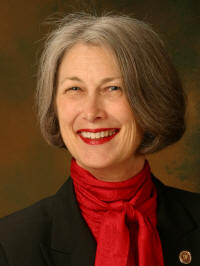University
Communications
Office
Arkansas State University
Jonesboro,
Arkansas
Staff
Markham Howe
Sara McNeil
Gina Bowman
(870) 972-3056
fax (870) 972-3069
More information:
NewsPage
Links to News Releases
& Announcements
Campus Calendar
Public activities at ASU
Campus News
Faculty and Staff
achievements
About
ASU
Overview, history
and more |
Dr. Susan Allen receives patent for body limb
movement limiter
July 31, 2008 --
Dr. Susan Allen, distinguished professor and director of the
Arkansas Center for Laser Applications and Science at Arkansas State
University, has been granted a personally owned patent for a body limb movement limiter. The
patent, granted to Dr. Allen July 22, resulted from a rollerblading
accident she sustained several years ago.
granted a personally owned patent for a body limb movement limiter. The
patent, granted to Dr. Allen July 22, resulted from a rollerblading
accident she sustained several years ago.
According to the
patent abstract, a body limb movement limiter restrains the movement of
a person’s arm to protect the person’s shoulder or restrains the
movement of a person’s lower leg with respect to the upper leg to
protect the person’s knee.
“Just like scientists are trained to think differently, inventors learn
to look at the world a little differently,” said Dr. Allen. “I knew
about non-Newtonian shear-thickening fluids from a conversation in
graduate school with a colleague. He told me that a popular Mattel toy,
“The Bee Says,” had a non-Newtonian switch in it.
“I remembered it because I thought it was really cool that
Mattel was using high-tech materials in their toys. When I dislocated my
shoulder trying to turn a corner while going a little too fast
rollerblading, I also broke my pelvis. During my recovery, I had my
immobilizer off at one point and was sitting down when I was startled by
something and reached out instinctively for the nearest wall with my bad
arm. It really hurt.”
Dr. Allen said she thought during her physical therapy that in order to
get her range of motion back that it would have been better to keep that
joint moving during the recovery period. She realized that she needed a
tether with a “squishy brake” and the non-Newtonian fluid from graduate
school came to mind.
Corn starch and
water or sand near the tide line are the shear-thickening non-Newtonian
fluids that most people will encounter, Dr. Allen explained.
“When you stir a thick paste of cornstarch and water slowly,
it moves, but if you try to stir it fast, your spoon freezes up,” she
said. “The same thing happens when you bury your feet in wet sand. You
wiggle them in but if you try to pull them out fast, it’s hard to
do. Properly designed, such a fluid would allow slow, deliberate
movement but would prevent rapid starts and stops and the forces on the
recovering joint that would accompany them.”
As a result, the
device aids in building strength and preventing the shortening of the
affected tendon or ligament. Dr. Allen’s invention prevents rapid
movement to a person’s shoulder, knee or other joint and allows the user
to move normally without discomfort while preventing sudden acceleration
of a person’s limb. Such hurried movement could cause reinjury, pain or
damage to a person’s joint.
The movement limiter consists of a housing framework containing a fluid
that thickens under acceleration and a reel. A tether is attached to the
housing case with the free end placed around the person’s arm. A strap
attached to the housing is secured around the torso. For a hinge joint
like a knee or elbow, two pairs of arms are each secured to a case
containing a similar fluid. This limits the movement of one pair of arms
with respect to the other, attached above and below the knee or elbow.
By way of Dr. Allen’s invention, a thickening fluid is able to produce a
body limb movement limiter that needs no external power source. However,
a sensor and electrically driven clamps, or electrically or magnetically
modified fluid viscosity, can also prevent the forces generated by rapid
acceleration.
The next step for Dr. Allen’s invention is marketing and distribution.
In addition, this marks the seventh patent issued to her, dating back to
1991. She said six more patents are currently under consideration at the
United States Patent and Trademark Office as well as several disclosures
pending with the ASU Office of Research and Technology Transfer.
###
|
